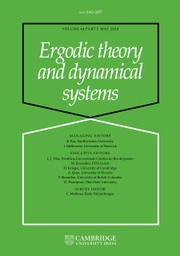Article contents
Smale solenoid attractors and affine Hirsch foliations
Published online by Cambridge University Press: 04 May 2017
Abstract
The main purpose of this paper is to study north–south Smale solenoid diffeomorphisms on  $3$-manifolds by using affine Hirsch foliations. A north–south Smale solenoid diffeomorphism
$3$-manifolds by using affine Hirsch foliations. A north–south Smale solenoid diffeomorphism  $f$ on a closed
$f$ on a closed  $3$-manifold
$3$-manifold  $M$ is a diffeomorphism whose non-wandering set is composed of a Smale solenoid attractor
$M$ is a diffeomorphism whose non-wandering set is composed of a Smale solenoid attractor  $\unicode[STIX]{x1D6EC}_{a}$ and a Smale solenoid repeller
$\unicode[STIX]{x1D6EC}_{a}$ and a Smale solenoid repeller  $\unicode[STIX]{x1D6EC}_{r}$. The key observation is that a north–south Smale solenoid diffeomorphism
$\unicode[STIX]{x1D6EC}_{r}$. The key observation is that a north–south Smale solenoid diffeomorphism  $f$ automatically induces two non-isotopically leaf-conjugate affine Hirsch foliations
$f$ automatically induces two non-isotopically leaf-conjugate affine Hirsch foliations  ${\mathcal{H}}^{s}$ and
${\mathcal{H}}^{s}$ and  ${\mathcal{H}}^{u}$ on the orbit space of the wandering set of
${\mathcal{H}}^{u}$ on the orbit space of the wandering set of  $f$ (abbreviated to the wandering orbit space of
$f$ (abbreviated to the wandering orbit space of  $f$) by the stable and unstable manifolds of
$f$) by the stable and unstable manifolds of  $\unicode[STIX]{x1D6EC}_{a}$ and
$\unicode[STIX]{x1D6EC}_{a}$ and  $\unicode[STIX]{x1D6EC}_{r}$, respectively. Under this viewpoint, we build some close relationships between north–south Smale solenoid diffeomorphisms and Hirsch manifolds (the closed
$\unicode[STIX]{x1D6EC}_{r}$, respectively. Under this viewpoint, we build some close relationships between north–south Smale solenoid diffeomorphisms and Hirsch manifolds (the closed  $3$-manifolds admitting two non-isotopically leaf-conjugate affine Hirsch foliations).
$3$-manifolds admitting two non-isotopically leaf-conjugate affine Hirsch foliations).
∙ On the one hand, the union of the wandering orbit spaces is nearly in one-to-one correspondence with the union of Hirsch manifolds.
∙ On the other hand, surprisingly, the topology of the wandering orbit space (Hirsch manifold) is nearly a complete invariant of north–south Smale solenoid diffeomorphisms up to semi-global conjugacy.
Moreover, as applications, we consider several more concrete questions. For instance, we prove that every diffeomorphism in many semi-global conjugacy classes of north–south Smale solenoid diffeomorphisms are not structurally stable.
- Type
- Original Article
- Information
- Copyright
- © Cambridge University Press, 2017
References
- 1
- Cited by


